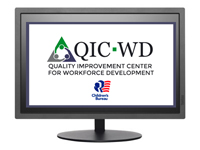Child Welfare Quality Improvement Center for Workforce Development (QIC-WD)
Date of this Version
4-14-2021
Document Type
Article
Abstract
Studies and our own assessment of secondary trauma in the eight QIC-WD study sites indicate that up to 75% of child welfare caseworkers, especially those with high caseloads and exposure to traumatized families and children, are at risk of experiencing secondary traumatic stress and PTSD. The Coronavirus pandemic exacerbated an already beleaguered workforce. Data from previous pandemics is alarming. Research from the SARS pandemic indicates that survivors often developed PTSD which could last for many years. Those most affected were health care workers who, similar to child welfare workers, were impacted by the social isolation imposed by authorities to contain the pandemic. And, like COVID-19, there was no full understanding of how the illness would progress and no known course of treatment. During COVID-19, child welfare workers were also apprehensive about the plummet in child maltreatment reporting since children were at home and away from the watchful community “eyes and ears” who might observe family stress and signs of maltreatment. Workers also feared spreading the coronavirus to their own families or to other families on their caseloads, especially when faced with a lack of personal protective equipment necessary to continue required in-person visits and investigations. Child welfare agency leadership, recognizing the potential for lasting harm among workers struggling to meet the demands of the pandemic, sought to develop resources to support and strengthen the workforce. The Quality Improvement Center for Workforce Development (QIC-WD) hosted a webinar, Coping in the Time of COVID, featuring evidence-based strategies to: • Manage stress while working from home, including the importance of physical activity; the necessity of adequate sleep; and, relaxation, mindfulness and breathing techniques. • Manage personal relationships during the pandemic including setting limits, developing a daily routine, and connecting with friends and family and communicating effectively. The QIC-WD also worked to curate useful lessons learned from two jurisdiction, Ohio and Nebraska, that implemented interventions to address worker secondary traumatic stress, pre-pandemic. Nebraska and Ohio offered Resilience Alliance (RA) in some locations to enhance workers’ ability to handle on-the-job and crisis-related stressors. In Nebraska, post-RA peer support groups (to continue skill building) were sustained in some locations during the pandemic. In some Ohio locations, post-RA check-in groups also continued during the pandemic. According to Summit County, Ohio caseworker Heather Murphy, “Since COVID-19 has changed the way we work with one another, RA is more important than ever. I am constantly using RA skills to help manage the new and different stressors we encounter from the pandemic.” In Ohio, RA was enhanced by supportive supervision. The QIC-WD also offered guidance on the critical role supervisors can play in helping workers navigate their way through the ongoing pandemic. This included defining expectations, setting realistic goals, communicating regularly with staff, and establishing regular, consistent check-ins with workers. Other jurisdictions, not involved in the QIC-WD, have considered how to build resilience and manage traumatic stress among the child welfare workforce. In 2017, for example, Colorado lawmakers enacted House Bill 17-1283 which created a task force to recommend guidelines for child welfare caseworker resiliency programs. Recommendations included education and training on resiliency and stress, and the implementation of cognitive-behavioral strategies and mindfulness-based methods, post-crisis debriefings, and peer support groups. Although evidence of the effectiveness of these interventions is still pending, child welfare agency leaders can work to ensure that their workforce is equipped with strategies to handle secondary traumatic stress, as an occupational hazard. These coping skills may be a protective factor for workers experiencing crises such as the pandemic.
Included in
Industrial and Organizational Psychology Commons, Performance Management Commons, Public Policy Commons, Social Welfare Commons, Social Work Commons, Training and Development Commons


